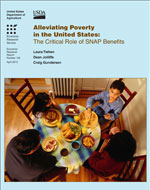Alleviating Poverty in the United States: The Critical Role of SNAP Benefits
- by Laura Tiehen, Dean Jolliffe and Craig Gundersen
- 4/9/2012
Overview
The Supplemental Nutrition Assistance Program (SNAP) is one of the largest safety net programs in the United States, serving 44.7 million individuals in an average month in 2011. We used Current Population Survey data to examine the effect of SNAP on poverty from 2000 to 2009, by adding program benefits to income and calculating how SNAP benefits affected the prevalence, depth, and severity of poverty. We found an average decline of 4.4 percent in the prevalence of poverty due to SNAP benefits, while the average decline in the depth and severity of poverty was 10.3 and 13.2 percent, respectively. SNAP benefits had a particularly strong effect on child poverty, reducing its depth by an average of 15.5 percent and its severity by an average of 21.3 percent from 2000 to 2009. SNAP's antipoverty effect peaked in 2009, when benefit increases were authorized by the American Recovery and Reinvestment Act. Our analysis shows that SNAP significantly improves the welfare of low-income households.
Download
-
Entire report
Download PDF -
Report summary
Download PDF -
zip file
Download ZIP

